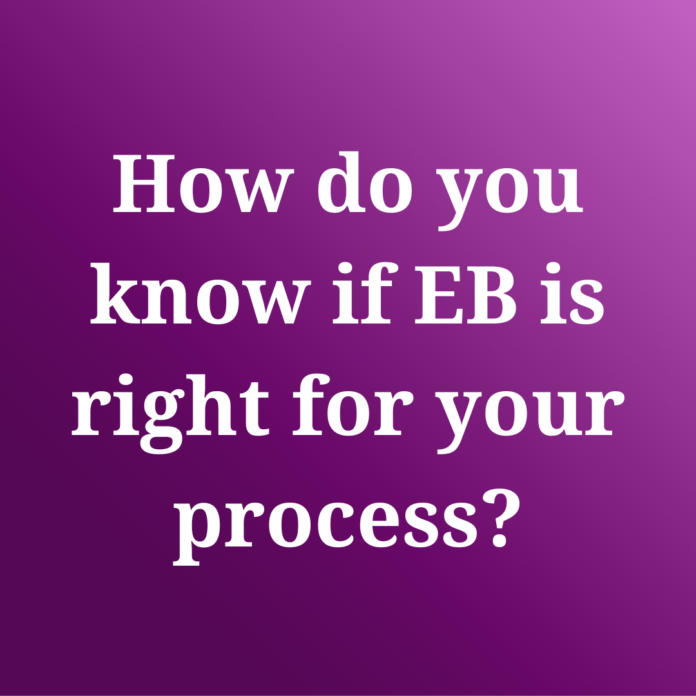So, you read an article or saw a presentation about electron beam, and phrases like solvent free, low energy or colorblind had you swooning. But how do you know if EB is right for your process? Or which EB to buy? Or if it will fit in your line? Oh my! Whether you’re switching processing technologies or developing a whole new process, it’s quite easy to be overwhelmed by all the bits and pieces that need to be considered. Below are a few guideposts to steer you through the process.
Reach out
EB equipment manufacturers and organizations like RadTech1 are more than happy to answer questions and familiarize new users with the basics of EB. You’re not the first, and certainly won’t be the last, to have an interest in EB but not know exactly how it works or what it does. In addition to reaching out directly, there generally are resources on manufacturers’ websites and past UV+EB Technology articles for those who prefer do some
reading first.
Trial work
Once you’ve got a handle on the basics, the next step usually is to do a trial or two. Trials are an important step in the process of becoming an EB user for several reasons. Have you got a novel idea for an EB process? The easiest way to see what will happen is to just try it out. Even for well-established EB applications, like the crosslinking of polyethylene, the aspects of the film that are product specific – things like branching, crystallinity, additives – can influence the properties resulting from EB exposure and/or the dose (EB energy) required to achieve certain material properties. Similarly, while EB may be known to be used successfully in an application, the details might be more proprietary than public.
If a process will need coatings, adhesives or any other sort of chemistry, trials are a good opportunity to interact with these suppliers. You can compare their offerings, request any modifications that might be needed and establish the required dose and voltage settings2 – the latter being a necessary piece of information for an EB purchase. The build of an EB system can extend over several months, so making use of this time through trial work can help ensure you’re ready to begin production shortly after the system is installed.
Trials generally take place at an EB manufacturer’s facility or that of a coating/adhesive supplier, although there are some EB users that allow outside trials. Initial work may be done on a lab-scale unit that can handle small sheet samples. Once you’ve made certain that the new EB-curable formulation will, in fact, come out of the system dry, for example, it can be scaled up to a roll-to-roll line.
People say seeing is believing, but in the case of an EB trial, it might be more accurate to say seeing is gaining understanding. Especially if you’re coming from a background outside the UV/EB sphere, attending a trial is a great way of learning about electron beam but also understanding the larger scope of what it means to integrate an electron beam into a processing line. For example, a trial provides insight into what settings the operator does and does not pay attention to; how to adjust the coating when you can’t just add solvent; or even how to clean up after production is complete. There are multiple aspects of the electron beam and/or the accompanying chemistry that might impact upstream or downstream processes in small or large ways, and these aren’t always forefront of mind to ask about until you’ve seen an EB line operate firsthand.
Benefits/return on investment
Electron beams can range in price from several hundred thousand dollars to several million dollars, depending on factors such as size, throughput and customization. Company policies and politics vary, but it is not uncommon for EB sticker shock to be a stumbling block as the capital investment request makes its way up the corporate ladder without the rest of the relevant information. As you consider an EB purchase, price is only one half of the equation. The other half consists of a whole host of other considerations – benefits to the product (maybe discovered during trials!); energy savings; space savings; the sustainability aspects; supply chain security, if you’re bringing a process in-house; and the list goes on. If you think EB is the right solution for your process, be prepared to do the math so that others in the company also can also see the value EB brings.
EB design and facility considerations
Electron beams come in all shapes and sizes, and there are a few criteria used to select which design will work for your process. Remember the dose and accelerating voltage ranges that were established during trials? Those are key parameters for determining the power supply size (mA/kV) and the electron beam group/family.2 EBs create x-rays as a byproduct and are shielded to attenuate these x-rays to safe levels. The higher the accelerating voltage, the thicker the shielding required, so electron beam designs are divided into families that have different maximum voltage capabilities to reduce cost and footprint for applications that only need lower voltages.
Material handling is another important consideration. The majority of low-energy electron beams (≤300 kV) are designed for a continuous web, but EBs for sheetfed and other more specialized processes also exist.3 When engineering a new design, ray tracing is done to ensure that x-rays will be attenuated sufficiently either by thicknesses of lead and steel or by a number of angle changes at the inlet and outlet of the beam. The form (web, sheet, 3D, etc.) and properties of the material being conveyed influence the shielding design, which is a major aspect of the beam.
Electron beam design also can be influenced or constrained by the facility. Is there limited space for the EB because it is being retrofitted into an existing line? Will that effect the web entry angle or height? In addition to the electron beam itself, there needs to be space set aside for the power supply and control cabinet within a certain distance as the high-voltage cable connecting the power supply to the electron beam has a limited length. Other facility requirements include electricity, cooling water and, in most cases, nitrogen. An EB manufacturer will work with you to address these considerations and make known what specifics the beam requires.
References
- www.radtech.org
- Schissel, S. EB Operation 101. UV+EB Technology, (1) 2021.
- Schissel, S. EB in 3D?. UV+EB Technology, (4) 2020.
 Sage Schissel, PhD
Sage Schissel, PhD
Applications Specialist
PCT Ebeam and Integration LLC
sage.schissel@pctebi.com






